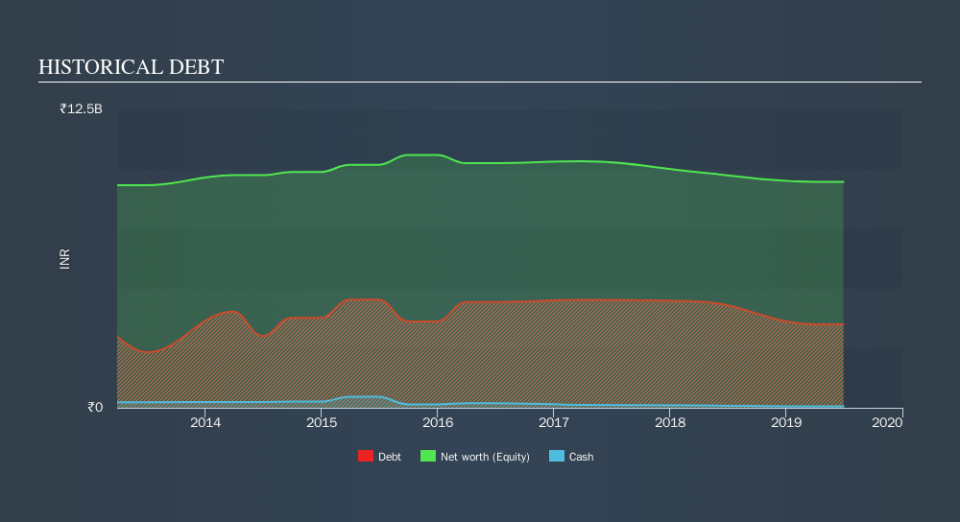Is Country Club Hospitality & Holidays (NSE:CCHHL) Using Too Much Debt?

The external fund manager backed by Berkshire Hathaway's Charlie Munger, Li Lu, makes no bones about it when he says 'The biggest investment risk is not the volatility of prices, but whether you will suffer a permanent loss of capital.' So it seems the smart money knows that debt - which is usually involved in bankruptcies - is a very important factor, when you assess how risky a company is. Importantly, Country Club Hospitality & Holidays Limited (NSE:CCHHL) does carry debt. But should shareholders be worried about its use of debt?
Why Does Debt Bring Risk?
Debt assists a business until the business has trouble paying it off, either with new capital or with free cash flow. If things get really bad, the lenders can take control of the business. While that is not too common, we often do see indebted companies permanently diluting shareholders because lenders force them to raise capital at a distressed price. Having said that, the most common situation is where a company manages its debt reasonably well - and to its own advantage. The first thing to do when considering how much debt a business uses is to look at its cash and debt together.
View our latest analysis for Country Club Hospitality & Holidays
How Much Debt Does Country Club Hospitality & Holidays Carry?
As you can see below, Country Club Hospitality & Holidays had ₹3.50b of debt at March 2019, down from ₹4.45b a year prior. Net debt is about the same, since the it doesn't have much cash.
A Look At Country Club Hospitality & Holidays's Liabilities
We can see from the most recent balance sheet that Country Club Hospitality & Holidays had liabilities of ₹1.89b falling due within a year, and liabilities of ₹4.63b due beyond that. On the other hand, it had cash of ₹59.5m and ₹941.8m worth of receivables due within a year. So it has liabilities totalling ₹5.52b more than its cash and near-term receivables, combined.
The deficiency here weighs heavily on the ₹670.2m company itself, as if a child were struggling under the weight of an enormous back-pack full of books, his sports gear, and a trumpet. So we definitely think shareholders need to watch this one closely. At the end of the day, Country Club Hospitality & Holidays would probably need a major re-capitalization if its creditors were to demand repayment. There's no doubt that we learn most about debt from the balance sheet. But you can't view debt in total isolation; since Country Club Hospitality & Holidays will need earnings to service that debt. So when considering debt, it's definitely worth looking at the earnings trend. Click here for an interactive snapshot.
Over 12 months, Country Club Hospitality & Holidays saw its revenue drop to ₹2.5b, which is a fall of 21%. To be frank that doesn't bode well.
Caveat Emptor
While Country Club Hospitality & Holidays's falling revenue is about as heartwarming as a wet blanket, arguably its earnings before interest and tax (EBIT) loss is even less appealing. Indeed, it lost ₹6.4m at the EBIT level. Reflecting on this and the significant total liabilities, it's hard to know what to say about the stock because of our intense dis-affinity for it. Like every long-shot we're sure it has a glossy presentation outlining its blue-sky potential. But the reality is that it is low on liquid assets relative to liabilities, and it lost ₹527m in the last year. So we think buying this stock is risky, like walking through a minefield with a mask on. When we look at a riskier company, we like to check how their profits (or losses) are trending over time. Today, we're providing readers this interactive graph showing how Country Club Hospitality & Holidays's profit, revenue, and operating cashflow have changed over the last few years.
Of course, if you're the type of investor who prefers buying stocks without the burden of debt, then don't hesitate to discover our exclusive list of net cash growth stocks, today.
We aim to bring you long-term focused research analysis driven by fundamental data. Note that our analysis may not factor in the latest price-sensitive company announcements or qualitative material.
If you spot an error that warrants correction, please contact the editor at editorial-team@simplywallst.com. This article by Simply Wall St is general in nature. It does not constitute a recommendation to buy or sell any stock, and does not take account of your objectives, or your financial situation. Simply Wall St has no position in the stocks mentioned. Thank you for reading.

